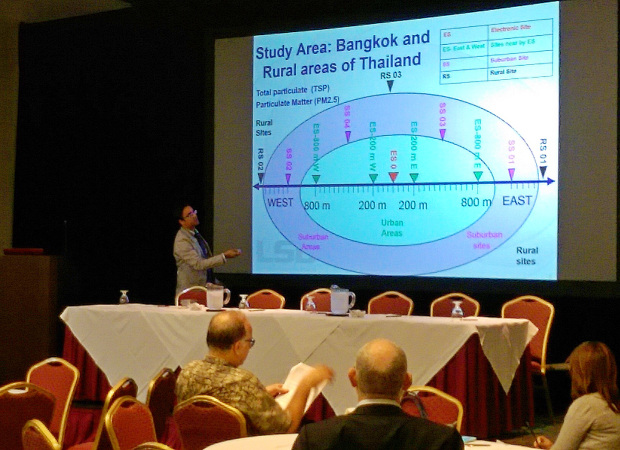LSU SRP Attends Annual Superfund Research Program Meeting

On November 18th-20th members of the Louisiana State Superfund Research Center (LSU SRC) attended the 2015 Annual NIEHS Superfund Research Program Meeting in San Juan, Puerto Rico. The meeting was hosted by the Puerto Rico Testsite for Exploring Contamination Threats (PROTECT) Program. PROTECT is a collaborative research program studying how to reduce pre-term births and involves four institutions: Northeastern University, University of Puerto Rico Medical Sciences Campus, University of Puerto Rico Mayaguez, and University of Michigan.
Research at the LSU SRC focuses on a newly identified pollutant-particle system called environmentally persistent free radicals (EPFRs). The LSU SRC research goal is to understand how EPFRs form and the ways in which they can affect pulmonary and cardiac function so that strategies can be developed to protect human health. Twelve researchers from of the LSU SRC presented posters at the meeting and one trainee, PhD candidate Ajit Ghimire, presented his research titled “Polybrominated diphenylethers (PBDEs) in ambient air samples at an electronic waste (e-waste) reclamation site” in a scientific session with the theme of “Mixtures”. The annual conference in San Juan was attended by twenty-one members of the LSU SRC: ten trainees, eight project/core leaders, and three administrative staff members. Overall, the annual conference featured work by twenty-five researchers from the LSU Superfund group.
At the meeting, LSU SRC Director Dr. Stephania Cormier was re-elected as Leader of the Superfund Directors’ Working Group. Her responsibilities include organizing the Superfund Research Program’s directors to engage and educate the community on the importance Superfund work as well as planning and chairing the NIEHS Director’s meeting at the annual Society of Toxicology meeting and the Director’s meeting at the NIEHS Annual SRP Meeting.
The Superfund Research Program (SRP) is funded by the National Institutes of Health (NIH) through the National Institute of Environmental Health Sciences (NIEHS). The SRP funds university-based multidisciplinary research on human health and environmental issues related to hazardous substances. According to the NIEHS website regarding the SRP, the “central goal is to understand and break the link between chemical exposure and disease.”
The annual meeting in San Juan was attended by many institutions and researchers. Representatives from Superfund programs around the country were present as well as representatives from partner agencies including the U.S. Environmental Protection Agency and the Agency for Toxic Substances and Disease Registry. The theme for the meeting was “SRP Collaboration for Innovation”. The meeting sought to identify how collaboration across disciplines within SRP centers, across different SRP centers, or even with external partners has generated innovation in biomedical and environmental basic and applied research, training, community engagement and research translation activities.
LSU Presenters and Poster Titles:
| Asmaa Sallam | Neonatal PM Exposure Induces a Regulatory Dendritic Cell Phenotype in the Lung via β-catenin signaling |
| Sridhar Jaligama | Combustion Derived Particulate Matter Exposure Suppresses Pulmonary Host Defense through Regulatory T cells and IL10 |
| Jaglia Wesley | The Effects of Air Pollution on Severity of Respiratory Illness |
| Ashlyn Harmon | Pulmonary inflammation and injury caused by environmentally persistent free radicals is mediated through activation of the aryl hydrocarbon receptor |
| Balamurugan Subramanian | The Effect of the Nature of Metal Oxide on the Formation and Persistency of Environmentally Persistent Free Radicals |
| Elisabeth Feld | The Role of Sulfur as an Environmentally Persistent Free Radical (EPFR) Suppressant |
| Kurt Varner | Environmentally Persistent Free Radicals Increase Systolic Blood Pressure and Block Compensatory Responses to Cardiac Stress in Rats with Ischemic Heart Disease |
| Wayne Backes | Environmentally Persistent Free Radicals Inhibit CYP1A2 and CYP2B4 by Different Mechanisms |
| Ansonia Badgett | Controlled Polymerization of SiO2 Shell for the Synthesis of Highly Fluorescent Up-Conversion Environmentally Persistent Free Radical Surrogates |
| Chuqi Guo | Environmentally Persistent Free Radicals (EPFRs) in Airborne Particular Matter (PM) – Sampling Artifacts |
| Xia Guan | Iron and Copper Synergy in the formation of PCDD/Fs |
| Margaret Reams | Engaging Community Partners and Public Agencies in the Scientific and Regulatory Challenges Associated with an Emerging Contaminant: Environmentally Persistent Free Radicals |
| Margaret Reams | Toxic landscapes, environmental justice and the community: An assessment of citizen participation in Superfund site remediation in the EPA’s 6th region |